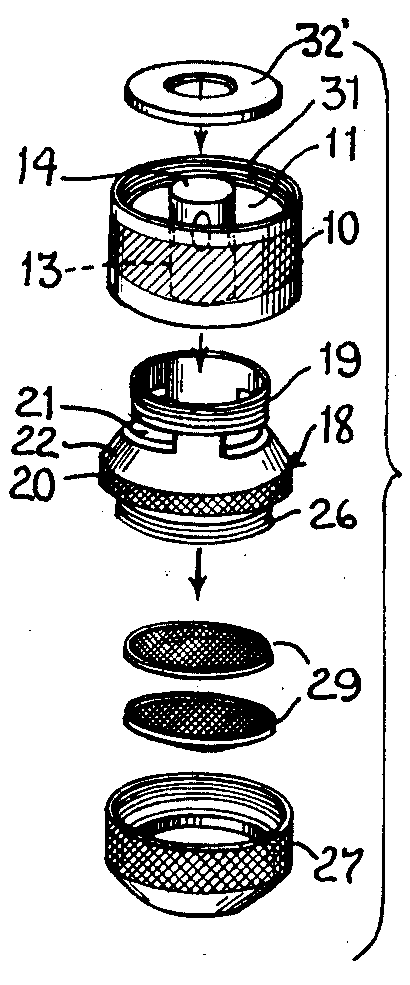Faucet aerator on:
[Wikipedia]
[Google]
[Amazon]
A faucet aerator (or tap aerator) is often found at the tip of modern indoor water
 Aeration occurs in two basic steps:
# Air is drawn into the water stream, breaking the stream into a flow of tiny droplets mixed with air.
# The mixture of air and water passes through a screen, further mixing the air and water and evenly spreading out the resulting stream.
Aeration occurs in two basic steps:
# Air is drawn into the water stream, breaking the stream into a flow of tiny droplets mixed with air.
# The mixture of air and water passes through a screen, further mixing the air and water and evenly spreading out the resulting stream.
faucets
A tap (also spigot or faucet: see usage variations) is a valve controlling the release of a liquid or gas.
Nomenclature
United Kingdom
* Tap is used in the United Kingdom and most of the Commonwealth for any everyday type of valve, parti ...
. Aerators can simply be screwed onto the faucet head, creating a non-splashing stream and often delivering a mixture of water and air.
Function
An aerator can: * Prevent splashing * Shape the water stream coming out of the faucet spout, to produce a straight and evenly pressured stream * Conserve water and reduce energy costs * Reduce faucet noise * Increase perceived water pressure (often used in homes with low water pressure); sometimes described as apressure regulator
A pressure regulator is a valve that controls the pressure of a fluid or gas to a desired value, using negative feedback from the controlled pressure. Regulators are used for gases and liquids, and can be an integral device with a pressure setti ...
or flow regulator
* Provide slight filtration of debris due to a small sieve plate
Splash prevention
When a single stream of water hits a surface the water must go somewhere, and because the stream is uniform the water will tend to go mostly in the same direction. If a single stream hits a surface which is curved, then the stream will conform to the shape and be easily redirected with the force of the volume of water falling. Adding the aerator does two things: it reduces the volume of falling water which reduces the splash distance, and it creates multiple "mini-streams" within the main stream. Each mini-stream, if it were falling by itself, would splash or flow in a unique and different way when it hit the surface, as compared to the other mini-streams. Because they are all falling at the same time, the streams will splash in their own way but end up hitting other splash streams. The resulting interference cancels out the majority of the splashing effect.Conservation and energy reduction
Because the aerator limits the water flow through the faucet, water usage is reduced compared to the same duration of flow without an aerator. In the case of hot water, because less water is used, less heat energy is used.Perceived water pressure
The perception of water pressure is actually the speed of the water as it hits a surface (the hands, in the case of hand washing). When an aerator is added to the faucet (or fluid stream), there is a region of high pressure created behind the aerator. Because of the higher pressure behind the aerator and the low pressure in front of it (outside the faucet), due toBernoulli's principle
In fluid dynamics, Bernoulli's principle states that an increase in the speed of a fluid occurs simultaneously with a decrease in static pressure or a decrease in the fluid's potential energy. The principle is named after the Swiss mathematici ...
there is an increase in velocity of the fluid flow.
Process
 Aeration occurs in two basic steps:
# Air is drawn into the water stream, breaking the stream into a flow of tiny droplets mixed with air.
# The mixture of air and water passes through a screen, further mixing the air and water and evenly spreading out the resulting stream.
Aeration occurs in two basic steps:
# Air is drawn into the water stream, breaking the stream into a flow of tiny droplets mixed with air.
# The mixture of air and water passes through a screen, further mixing the air and water and evenly spreading out the resulting stream.
Design and features
Three major components of an aerator are: housing, insert and rubber washer. A faucet aerator can be classified on the basis of its flow rate and the type of water stream (aerated, non-aerated, spray) it produces. In general, standard-sized aerators are available with female (M22x1) or male threading (M24x1). Bathtub spouts often have a bigger diameter with a male M28x1 thread. The United States uses different thread sizes: "-27 for standard-sized male and "-27 for standard-sized female threads. Using faucet aerators may help meet local regulations and construction standards such as ASME A112.18.1, U.S.Leadership in Energy and Environmental Design
Leadership in Energy and Environmental Design (LEED) is a
green building certification program used worldwide. Developed by the non-profit U.S. Green Building Council (USGBC), it includes a set of rating systems for the design, construction ...
(LEED) certifications or WELS
Wels (; Central Bavarian: ''Wös'') is a city in Upper Austria, on the Traun River near Linz. It is the county seat of Wels-Land, and with a population of approximately 60,000, the eighth largest city in Austria.
Geography
Wels is in the H ...
(Australia/New Zealand). In Europe, European standard EN246 "Sanitary tapware - General specifications for flow rate regulators" defines the flow rate and noise reduction requirements.
References
{{DEFAULTSORT:Faucet Aerator Plumbing Valves